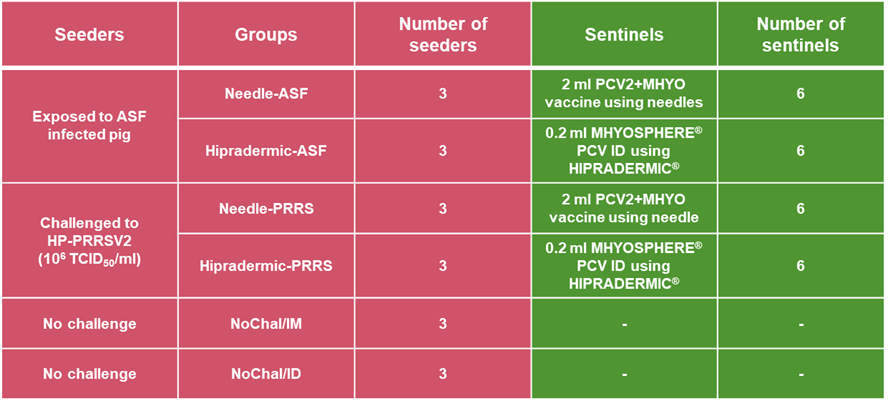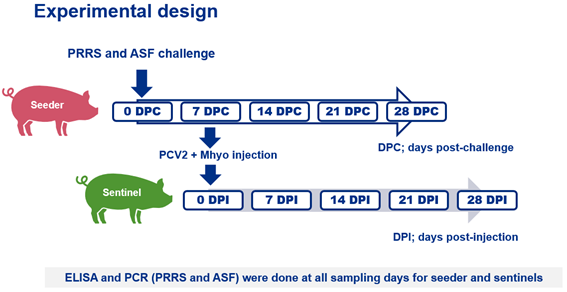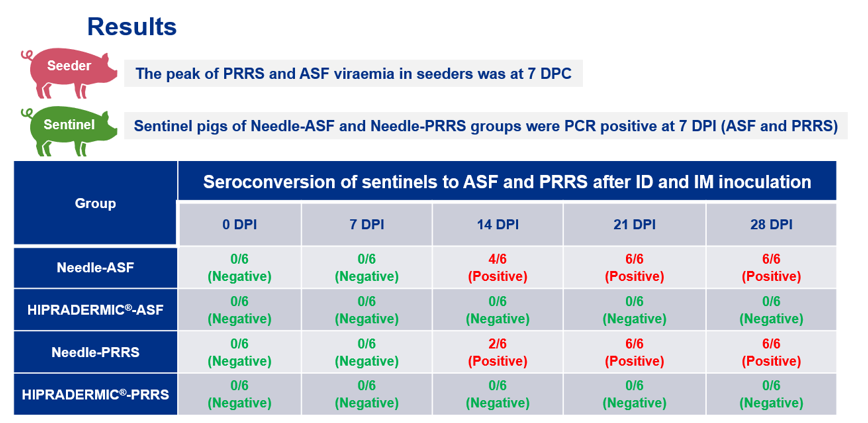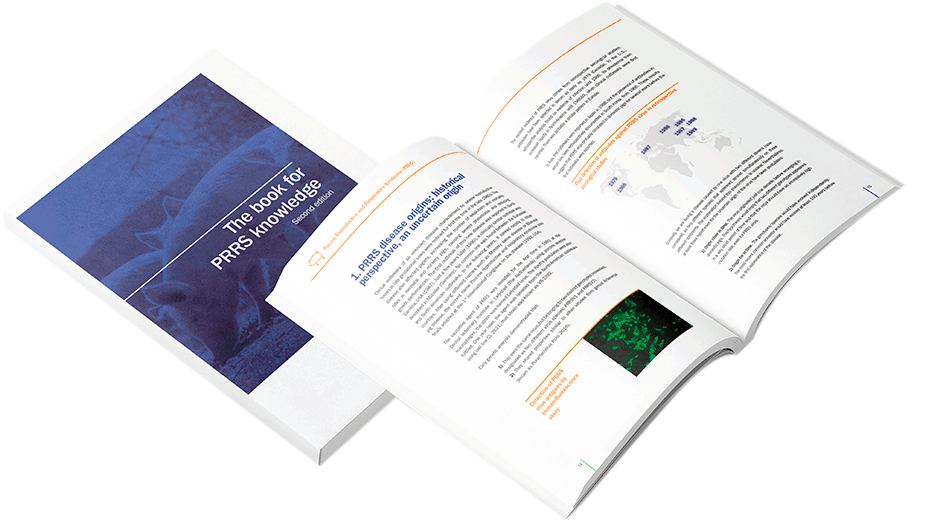Evaluation of ASF and PRRS virus transmission between pigs when using conventional needle and needle-free device
Introduction
Porcine reproductive and respiratory syndrome (PRRS), a devastating disease in pigs characterized by respiratory and reproductive disease, has been present in Southeast Asia (SEA) since 90’s [1]. In addition to PRRS, the widespread of African swine fever (ASF) in this SEA region has increased a threat to ASF free herds [2]. Intramuscular administration using needles has been the main route of vaccination in pigs although, risks associated with conventional needles are high. PRRS virus (PRRSV), for instance, was transmitted by conventional needles and was able to induce the disease in naïve pigs [3].
Therefore, the objectives of this study were to evaluate African swine fever virus (ASF) and porcine reproductive and respiratory syndrome virus (PRRSV) transmission between conventional needle and needle-free device.
Materials and Methods
In the present study, forty-two, 3-week-old pigs were procured from a herd free of ASF and PRRSV. The negative statuses against both pathogens were confirmed by PCR in blood samples upon arrival.
Eighteen pigs were randomly allocated into 6 groups called seeders of 3 pigs each including IM/ASF, ID/ASF, IM/PRRSV, ID/PRRSV and 2 controls groups NoChal/IM and NoChal/ID.
Twenty-four age-matched pigs divided in 4 groups of 6 each as sentinels including IM/ASFsent, ID/ASFsent, IM/PRRSVsent and ID/PRRSVsent.

At 0 days post exposure (DPE), IM/ASF and ID/ASF groups were exposed to ASF infected pigs. IM/PRRSV and ID/PRRSV groups were intranasally inoculated with 4 ml of HP-PRRSV-2 (106 TCID50/ml, 2 ml/nostril).
At 7 DPE (0 days post injection (DPI)), IM/ASF and IM/PRRSV groups were intramuscularly administered with 2 ml of a bivalent porcine circovirus type 2 (PCV2) and Mycoplasma hyopneumoniae (Mhyo) vaccine using conventional needles.
ID/ASF and ID/PRRSV groups were intradermally administered with 0.2 ml of a PCV2 and Mhyo vaccine (MHYOSPHERE® PCV ID, HIPRA) using needle-free device (Hipradermic®, HIPRA). Also, at 7 DPE the same conventional needles and needle-free device were used to inject the same volume of the vaccine to the animals of the sentinels groups (1 exposed pig to 2 sentinels) with the same route of injection for each.
Blood samples were collected from seeders at 0, 7, 14, 21 and 28 DPE, and sentinels at 0, 7, 14, 21 and 28 DPI. ASF and PRRSV antibodies and viremia were evaluated using ELISA and RT-qPCR respectively.

Results
The results demonstrated that ASF and PRRSV seeders groups had the highest viremia at 7 DPE. Following injection, sentinel pigs of IM/ASFsent and IM/PRRSVsent groups were PCR positive at 7 DPI. In contrast, sentinel pigs of both ID/ASFsent and ID/PRRSVsent groups were PCR negative throughout the experiment.
Seroconversion results show us that the IM/ASFsent and IM/PRRSsent groups had positive animals at 14 DPI, on the other hand, ID/ASFsent and ID/PRRSsent groups were negative throughout the experiment.

Discussion and Conclusion
Our findings revealed the potential of ASF and PRRSV transmission through needle during vaccination.
Otherwise, the possibility of applying intradermal vaccines with a needle-free device such as Hipradermic® inhibits both ASF and PRRSV transmission and could be used for alternative route of vaccination avoiding iatrogenic transfer of pathogens between animals with shared needles.
Acknowledgments
This study was supported by Chulalongkorn University (Fundamental fund, grant number 65413100200013, CUFRB65_food(26)190_31_09).
If you want to read more publications about PRRS: Publications
You can ask your own question! Visit Pig333.com and submit your question to the experts.
References
- Nilubol D et al. 2013. Genetic diversity of ORF5 gene of porcine reproductive and respiratory syndrome virus (PRRSV) genotypes I and II in Thailand. 158, 943-53.
- Le V et al. 2019. Outbreak of African Swine Fever, Vietnam, 2019. 25, 1433-1435.
- Madapong A et al. 2021 Safety of PRRSV-2 MLV vaccines administrated via the intramuscular or intradermal route and evaluation of PRRSV transmission upon needle-free and needle delivery. 11, 23107.

Swine Viral Evolution and Vaccine Research Unit, Chulalongkorn University, Thailand.



